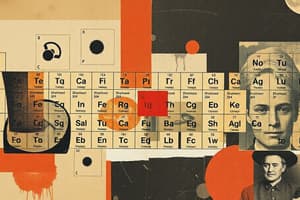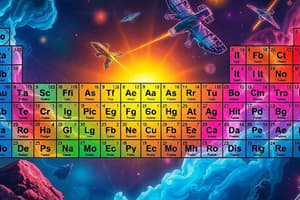Podcast
Questions and Answers
What is the periodic law?
What is the periodic law?
Law that states that the physical and chemical properties of the elements are periodic functions of their atomic numbers.
What is a group in the periodic table?
What is a group in the periodic table?
A column of elements in the periodic table; family.
What defines a family in the periodic table?
What defines a family in the periodic table?
A column of elements in the periodic table; group.
What is a period in the periodic table?
What is a period in the periodic table?
What is a metal?
What is a metal?
What does luster refer to?
What does luster refer to?
What does ductile mean?
What does ductile mean?
What does malleable mean?
What does malleable mean?
What is corrosion?
What is corrosion?
What defines a nonmetal?
What defines a nonmetal?
What is a metalloid?
What is a metalloid?
What is an alkali metal?
What is an alkali metal?
What is an alkaline earth metal?
What is an alkaline earth metal?
What is a transition metal?
What is a transition metal?
What is the boron family?
What is the boron family?
What is the carbon family?
What is the carbon family?
What is the nitrogen family?
What is the nitrogen family?
What is the oxygen family?
What is the oxygen family?
What is the halogen family?
What is the halogen family?
What is a noble gas?
What is a noble gas?
What are rare-earth elements?
What are rare-earth elements?
What is the lanthanoid series?
What is the lanthanoid series?
What is the actinoid series?
What is the actinoid series?
Flashcards are hidden until you start studying
Study Notes
Periodic Law and Table Structure
- Periodic law: The physical and chemical properties of elements are periodic functions of their atomic numbers.
- Groups: Vertical columns in the periodic table, also referred to as families.
- Periods: Horizontal rows of elements in the periodic table.
Properties of Elements
- Metals: Good conductors of heat and electricity, shiny, high melting points, ductile, malleable, and tend to lose electrons.
- Luster: Indicates the shiny appearance of an element.
- Ductility: Refers to the ability of a metal to be drawn into thin wires.
- Malleability: Describes the capability of a metal to be hammered into thin sheets.
- Corrosion: The gradual wearing away of metals due to chemical reactions, resulting in the formation of metallic compounds.
- Nonmetals: Poor conductors of heat and electricity, dull surfaces, low melting points, brittle, and tend to gain electrons.
- Metalloids: Elements exhibiting properties of both metals and nonmetals.
Specific Families of Elements
- Alkali Metals: Family 1 elements characterized by having 1 valence electron.
- Alkaline Earth Metals: Family 2 elements with 2 valence electrons.
- Transition Metals: Elements with properties similar to other transition metals but do not fit neatly into any specific family.
Element Families by Valence Electrons
- Boron Family: Family 13 elements possess 3 valence electrons.
- Carbon Family: Family 14 elements have 4 valence electrons.
- Nitrogen Family: Family 15 elements contain 5 valence electrons.
- Oxygen Family: Family 16 elements have 6 valence electrons.
- Halogen Family: Family 17 elements contain 7 valence electrons.
- Noble Gases: Family 18 elements have 8 valence electrons and are highly unreactive.
Rare-Earth Elements
- Rare-Earth Elements: General term for elements in the lanthanoid and actinoid series.
- Lanthanoid Series: First row of rare-earth elements, known for being soft, malleable metals with high luster and conductivity.
- Actinoid Series: Second row of rare-earth elements, noted for being radioactive, with all but three being synthetic.
Studying That Suits You
Use AI to generate personalized quizzes and flashcards to suit your learning preferences.




